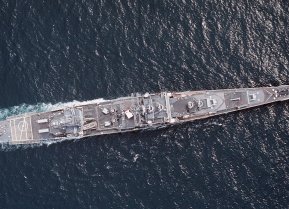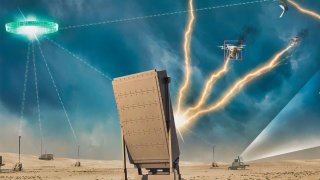Project METEOR: The Navy's Plan for High Power Microwave Weapons
The United States Navy is now developing high-powered microwave technology in a new program called Project METEOR. It could change how the U.S. military thinks about 21st-century warfare.
The United States Navy is now developing high-powered microwave technology, but this isn't an April Fools' Day joke. The technology won't heat up the chow for sailors, but rather could protect them from airborne threats and the sea service is moving forward with plans to mount a high-powered microwave system on a vessel as early as 2026.
According to the U.S. Navy's Fiscal Year 2025 (FY25) budget request documents, the system is being developed under Project METEOR, which is developing a directed energy weapon (DEW) system prototype. METEOR could "provide capability with low cost-per-shot, deep magazine, tactically significant range, short time engagement for multi-target approach, dual deception and defeat capability," the budget documents stated.
Enter Project METEOR: What Are DEWs?
The U.S. Navy's Office of Naval Research has been leading the DEW effort, which it explains "are defined as electromagnetic systems capable of converting chemical or electrical energy to radiated energy and focusing it on a target, resulting in physical damage that degrades, neutralizes, defeats, or destroys an adversarial capability. Navy DEWs include systems that use High Energy Lasers (HEL) that emit photons, and High Power Microwaves (HPM) that release radiofrequency waves."
The service could use DEWs for power projection and integrated defense missions.
High-power microwaves (HPW) are one type of DEW, and these "could create beams of electromagnetic energy over a broad spectrum of radio and microwave frequencies in both narrow-band (bandwidth ~< 1%) and wide-band (bandwidth >> 1%) with the intent of coupling/interacting with electronics within targeted systems either by causing damage or temporary disruption from which the system cannot self-recover in time to accomplish its mission," the Office of Naval Research added.
HPM has several key benefits including speed of light attack, deep magazines, and modest electrical power from the host platform, while they also employ broad beams for as wide area coverage as possible for simple targeting. Such weapons could be utilized in congested (urban) environments where kinetic weapons could have constricted use.
Such a system wouldn't replace higher-end surface-to-air missiles but would become another layer of aerial defense alongside those systems. As TheWarzone reported, such air defense missiles could be kept in reserve to counter anti-ship ballistic missiles, while drones and other threats could be taken out by the DEW HPMs.
Moreover, as the technology improves, HPMs – which could use the microwave energy to inflict damage to the electronics of its targets – could be used to defeat anti-ship ballistic missiles such as those now fielded by China's People's Liberation Army Rocket Force (PLARF).
The U.S. Navy's efforts are different from those of the Royal Navy, which has been developing its DragonFire platform, a line-of-sight laser beam that could hit a £1 coin at more than 3,000 feet away.
What Companies Are Involved?
The U.S. Navy hasn't announced what defense contractors are working on METEOR or similar programs, but in December Raytheon announced it will design, build, and test two high-power microwave antenna systems that will use directed energy to defeat airborne threats at the speed of light.
The systems are designed to be rugged and transportable for front-line deployment, the RTX subsidiary stated.
Under the three-year, $31.3 million contract from the Naval Surface Warfare Center Dahlgren Division, Raytheon will deliver prototype systems to the U.S. Navy and U.S. Air Force as part of the Directed Energy Front-line Electromagnetic Neutralization and Defeat (DEFEND) program, the company added.
Its HPM prototype systems also build on Raytheon's decades of experience developing capabilities like the Counter-Electronic High Power Microwave Extended Range Air Base Defense, known as CHIMERA.
Author Experience and Expertise: Peter Suciu
Peter Suciu is a Michigan-based writer. He has contributed to more than four dozen magazines, newspapers, and websites with over 3,200 published pieces over a twenty-year career in journalism. He regularly writes about military hardware, firearms history, cybersecurity, politics, and international affairs. Peter is also a Contributing Writer for Forbes and Clearance Jobs. You can follow him on Twitter: @PeterSuciu.
You can email the author: [email protected].
Image Credit: U.S. Air Force.


